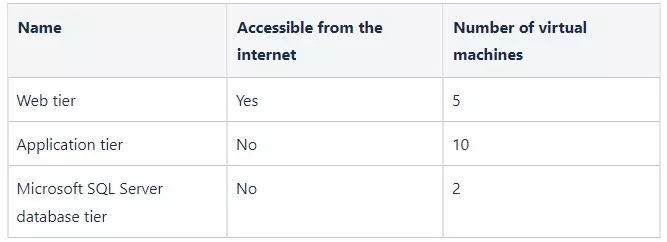Last updated on July 11, 2025
Here are 10 AZ-104 Microsoft Azure Administrator practice exam questions to help you gauge your readiness for the actual exam.
Question 1
Your company has an Azure Storage account named TutorialsDojo1.
You have to copy your files hosted on your on-premises network to TutorialsDojo1 using AzCopy.
What Azure Storage services will you be able to copy your data into?
- Table and Queue only
- Blob, Table, and File only
- Blob, File, Table, and Queue
- Blob and File only
Question 2
Your organization has deployed multiple Azure virtual machines configured to run as web servers and an Azure public load balancer named TD1.
There is a requirement that TD1 must consistently route your user’s request to the same web server every time they access it.
What should you configure?
- Hash based
- Session persistence: None
- Session persistence: Client IP
- Health probe
Question 3
Your company has a Microsoft Entra ID tenant named tutorialsdojo.onmicrosoft.com and a public DNS zone for tutorialsdojo.com.
You added the custom domain name tutorialsdojo.com to Microsoft Entra ID. You need to verify that Azure can verify the domain name.
What DNS record type should you use?
- A
- RRSIG
- SOA
- MX
Question 4
You have an existing Azure subscription that has the following Azure Storage accounts.
There is a requirement to identify the storage accounts that can be converted to zone-redundant storage (ZRS) replication. This must be done only through a live migration from Azure Support.
Which of the following accounts can you convert to ZRS?
- tdaccount1
- tdaccount2
- tdaccount3
- tdaccount4
Question 5
A company has two virtual networks named TDVnet1 and TDVnet2. A site-to-site VPN, using a VPN Gateway (TDGW1) with static routing, connects your on-premises network to TDVnet1. On your Windows 10 computer, TD1, you’ve set up a point-to-site VPN connection to TDVnet1.
You’ve recently established a virtual network peering between TDVnet1 and TDVnet2. Tests confirm connectivity to TDVnet2 from your on-premises network and to TDVnet1 from TD1. However, TD1 is currently unable to access TDVnet2.
What steps are necessary to enable a connection from TD1 to TDVnet2?
- Enable transit gateway for
TDVnet1. - Restart
TDGW1to re-establish the connection. - Download the VPN client configuration file and re-install it on
TD1. - Enable transit gateway for
TDVnet2.
Question 6
You have a file share in your Azure subscription named Manila-Subscription-01.
You plan to synchronize files from your on-premises file server named TDFileServer1 to Azure.
You created an Azure file share and a storage sync service.
Which four actions should you perform in sequence to synchronize files from TDFileServer1 to Azure?
Instructions: To answer, drag the appropriate item from the column on the left to its description on the right. Each correct match is worth one point.
Question 7
You have an Azure subscription named Davao-Subscription1.
You will be deploying a three-tier application as shown below:
Due to compliance requirements, you need to find a solution for the following:
-
Traffic between the web tier and application tier must be spread equally across all the virtual machines.
-
The web tier must be protected from SQL injection attacks.
Which Azure solution would you recommend for each requirement?
Select the correct answer from the drop-down list of options. Each correct selection is worth one point.
Question 8
You have the following resources deployed in Azure:
There is a requirement to connect TDVnet1 and TDVnet2.
What should you do first?
- Create virtual network peering.
- Change the address space of
TDVnet2. - Transfer
TDVnet1toTD2. - Transfer
VM1toTD2.
Question 9
You have an Azure subscription that contains an Azure virtual network named TDVnet1 with an address space of 10.1.0.0/18 and a subnet named TDSub1 with an address space of 10.1.0.0/22.
Your on-premises network has multiple branch offices, and you plan to connect them to Azure using a site-to-site VPN. You need to ensure that routing between your branch offices and Azure is dynamic and can adapt automatically to network changes.
Which four actions should you perform in sequence?
Instructions: To answer, drag the appropriate item from the column on the left to its description on the right. Each correct match is worth one point.
Question 10
Your company has an Azure subscription that contains the following resources:
| Virtual Network | Subnets |
| TDVnet1 | TDSub1, TDSub2 |
| TDVnet2 | TDSub3, TDSub4 |
| Virtual Machine | Subnet | Availability Set |
| TD1 | TDSub1 | TDSub1 |
| TD2 | TDSub1 | TDSub1 |
| TD3 | TDSub2 | TDSub2 |
| TD4 | TDSub2 | TDSub2 |
| TD5 | TDSub3 | TDSub3 |
| TD6 | TDSub3 | TDSub3 |
You plan to create an internal load balancer with the following parameters: Name: TDB1 SKU: Standard Subnet: TDSub2 Virtual network: TDVnet1 For each of the following items, choose Yes if the statement is true or choose No if the statement is false. Take note that each correct item is worth one point.
For more practice questions like these and to further prepare you for the actual AZ-900 AZ-104 Microsoft Azure Administrator exam, we recommend that you take our top-notch AZ-104 Microsoft Azure Administrator Practice Exams, which simulate the real unique question types in the AZ-900 exam such as drag and drop, dropdown, and hotspot.
Also, check out our AZ-104 Microsoft Azure Administrator exam study guide here.




 Every new Microsoft Entra ID tenant comes with an initial domain name, <domainname>.onmicrosoft.com. You can’t change or delete the initial domain name, but you can add your organization’s names. Adding custom domain names helps you to create user names that are familiar to your users, such as azure@tutorialsdojo.com.
Every new Microsoft Entra ID tenant comes with an initial domain name, <domainname>.onmicrosoft.com. You can’t change or delete the initial domain name, but you can add your organization’s names. Adding custom domain names helps you to create user names that are familiar to your users, such as azure@tutorialsdojo.com.




























